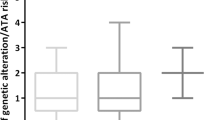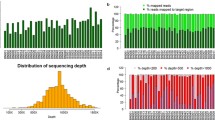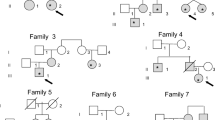Abstract
Thyroid cancer, predominantly of papillary histology (PTC), is a common cancer mostly diagnosed sporadically. Hereditary PTC is encountered in ~ 5% of cases and may present at an earlier age, with greater risks of metastasis and recurrence, compared with sporadic cases. The molecular basis of hereditary PTC is unknown in most cases. In this study, the genetic basis of hereditary PTC in three Brazilian families was investigated. Whole exome sequencing (WES) was carried out for probands in each family, and validated, pathogenic/likely pathogenic sequence variants (P/LPSVs) were genotyped in additional family members to establish their putative pathogenic role. Overall, seven P/LPSVs in seven novel genes were detected: p.D283N*ANXA3, p.Y157S*NTN4, p.G172W*SERPINA1, p.G188S*FKBP10, p.R937C*PLEKHG5, p.L32Q*P2RX5, and p.Q76*SAPCD1. These results indicate that these novel genes are seemingly associated with hereditary PTC, but extension and validation in other PTC families are required.

Similar content being viewed by others
References
Howlader N, Noone AM, Krapcho M, Miller D, Brest A, Yu M, Ruhl J, Tatalovich Z, Mariotto A, Lewis DR, Chen HS, Feuer EJ, Cronin KA, eds (2016) SEER Cancer Statistics Review, 1975–2016, National Cancer Institute. Bethesda, MD. Available from https://seer.cancer.gov/csr/1975_2016/.
Giordano TJ. Genomic hallmarks of thyroid neoplasia (2018) Annu Rev Pathol 13:141–162.
Ngan ES, Lang BH, Liu T, Shum CK, So MT, Lau DK, Leon TY, Cherny SS, Tsai SY, Lo CY, Khoo US, Tam PK, Garcia-Barceló MM (2009) A germline mutation (A339V) in thyroid transcription factor-1 (TITF-1/NKX2.1) in patients with multinodular goiter and papillary thyroid carcinoma. J Natl Cancer Inst 101:162–175.
He H, Nagy R, Liyanarachchi S, Jiao H, Li W, Suster S, Kere J, de la Chapelle A (2009) A susceptibility locus for papillary thyroid carcinoma on chromosome 8q24. Cancer Research 69:625–631.
Pereira JS, da Silva JG, Tomaz RA, Pinto AE, Bugalho MJ, Leite V, Cavaco BM (2015) Identification of a novel germline FOXE1 variant in patients with familial non-medullary thyroid carcinoma (FNMTC). Endocrine 49:204–214.
Gara SK, Jia L, Merino MJ, Agarwal SK, Zhang L, Cam M, Patel D, Kebebew E (2015) Germline HABP2 mutation causing familial nonmedullary thyroid cancer. N Engl J Med 373:448–455.
Tomsic J, He H, de la Chapelle A (2015) HABP2 Mutation and nonmedullary thyroid cancer. N Engl J Med 373:2086.
Tomsic J, Fultz R, Liyanarachchi S, He H, Senter L, de la Chapelle A (2016) HABP2 G534E variant in papillary thyroid carcinoma. PLoS One 11:e0146315.
Tomsic J, He H, Akagi K, Liyanarachchi S, Pan Q, Bertani B, Nagy R, Symer DE, Blencowe BJ, de la Chapelle A (2015) A germline mutation in SRRM2, a splicing factor gene, is implicated in papillary thyroid carcinoma predisposition. Sci Rep 5:10566.
Cavaco BM, Batista PF, Sobrinho LG, Leite V (2008) Mapping a new familial thyroid epithelial neoplasia susceptibility locus to chromosome 8p23.1-p22 by high-density single-nucleotide polymorphism genome-wide linkage analysis. J Clin Endocrinol Metab 93:4426–4430.
Suh I, Filetti S, Vriens MR, Guerrero MA, Tumino S, Wong M, Shen WT, Kebebew E, Duh QY, Clark OH (2009) Distinct loci on chromosome 1q21 and 6q22 predispose to familial nonmedullary thyroid cancer: a SNP array-based linkage analysis of 38 families. Surgery 146:1073–1080.
Sahasrabudhe R, Stultz J, Williamson J, Lott P, Estrada A, Bohorquez M, Palles C, Polanco-Echeverry G, Jaeger E, Martin L, Magdalena Echeverry M, Tomlinson I, Carvajal-Carmona LG; TCUKIN (2016) The HABP2 G534E variant is an unlikely cause of familial non-medullary thyroid cancer. J Clin Endocrinol Metab 10:1098–1103.
de Mello LEB, Araujo AN, Alves CX, de Paiva FJP, Brandão-Neto J, Cerutti JM (2017) The G534E variant in HABP2 is not associated with increased risk of familial nonmedullary thyroid cancer in Brazilian kindreds. Clin Endocrinol (Oxf) 87:113–114.
Pinheiro M, Drigo SA, Tonhosolo R, Andrade SCS, Marchi FA, Jurisica I, Kowalski LP, Achatz MI, Rogatto SR (2017) HABP2 p.G534E variant in patients with family history of thyroid and breast cancer. Oncotarget 8:40896–40905.
Choi Y, Sims GE, Murphy S, Miller JR, Chan AP (2012)Predicting the functional effect of amino acid substitutions and indels. PLoS One 7:e46688.
Dong C, Wei P, Jian X, Gibbs R, Boerwinkle E, Wang K, Liu X (2015) Comparison and integration of deleteriousness prediction methods for nonsynonymous SNVs in whole exome sequencing studies. Hum Mol Genet 24:2125–2137.
Wang Y, Liyanarachchi S, Miller KE, Nieminen TT, Comiskey DF Jr, Li W, Brock P, Symer DE, Akagi K, DeLap KE, He H, Koboldt DC, de la Chapelle A (2019) Identification of rare variants predisposing to thyroid cancer. Thyroid 29:946–955.
Du R, Liu B, Zhou L, Wang D, He X, Xu X, Zhang L, Niu C, Liu S (2018) Downregulation of annexin A3 inhibits tumor metastasis and decreases drug resistance in breast cancer. Cell Death Dis 9:126.
Jung EJ, Moon HG, Park ST, Cho BI, Lee SM, Jeong CY, Ju YT, Jeong SH, Lee YJ, Choi SK, Ha WS, Lee JS, Kang KR, Hong SC (2010) Decreased annexin A3 expression correlates with tumor progression in papillary thyroid cancer. Proteomics Clin Appl 4:528–537.
Lambert E, Coissieux MM, Laudet V, Mehlen P (2012) Netrin-4 acts as a pro-angiogenic factor during zebrafish development. J Biol Chem 287:3987–3999.
Xu X, Yan Q, Wang Y, Dong X (2017) NTN4 is associated with breast cancer metastasis via regulation of EMT-related biomarkers. Oncol Rep 37:449–457.
Lv B, Song C, Wu L, Zhang Q, Hou D, Chen P, Yu S, Wang Z, Chu Y, Zhang J, Yang D, Liu J (2014) Netrin-4 as a biomarker promotes cell proliferation and invasion in gastric cancer. Oncotarget 6:9794–9806.
Jayachandran A, Prithviraj P, Lo PH, Walkiewicz M, Anaka M, Woods BL, Tan B, Behren A, Cebon J, McKeown SJ (2016) Identifying and targeting determinants of melanoma cellular invasion. Oncotarget 7:41186–41202.
Eveno C, Contreres JO, Hainaud P, Nemeth J, Dupuy E, Pocard M (2013) Netrin-4 overexpression suppresses primary and metastatic colorectal tumor progression. Oncol Rep 29:73–78.
Latil A, Chêne L, Cochant-Priollet B, Mangin P, Fournier G, Berthon P, Cussenot O (2003) Quantification of expression of netrins, slits and their receptors in human prostate tumors. Int J Cancer 103:306–315.
Zhang J, Zheng F, Yu G, Yin Y, Lu Q (2013) miR-196a targets netrin 4 and regulates cell proliferation and migration of cervical cancer cells. Biochem Biophys Res Commun 440:582–588.
Kwon CH, Park HJ, Choi JH, Lee JR, Kim HK, Jo HJ, Kim HS, Oh N, Song GA, Park DY (2015) Snail and serpinA1 promote tumor progression and predict prognosis in colorectal cancer. Oncotarget 6:20312–20326.
Farshchian M, Kivisaari A, Ala-Aho R, Riihilä P, Kallajoki M, Grénman R, Peltonen J, Pihlajaniemi T, Heljasvaara R, Kähäri VM (2011) Serpin peptidase inhibitor clade A member 1 (SerpinA1) is a novel biomarker for progression of cutaneous squamous cell carcinoma. Am J Pathol 179:1110–1119.
Vierlinger K, Mansfeld MH, Koperek O, Nöhammer C, Kaserer K, Leisch F (2011) Identification of SERPINA1 as single marker for papillary thyroid carcinoma through microarray meta analysis and quantification of its discriminatory power in independent validation. BMC Med Genomics 4:30.
Matta J, Morales L, Dutil J, Bayona M, Alvarez C, Suarez E (2013) Differential expression of DNA repair genes in Hispanic women with breast cancer. Mol Cancer Biol 1:54.
Liu Y, Lusk CM, Cho MH, Silverman EK, Qiao D, Zhang R, Scheurer ME, Kheradmand F, Wheeler DA, Tsavachidis S, Armstrong G, Zhu D, Wistuba II, Chow CB, Behrens C, Pikielny CW, Neslund-Dudas C, Pinney SM, Anderson M, Kupert E, Bailey-Wilson J, Gaba C, Mandal D, You M, de Andrade M, Yang P, Field JK, Liloglou T, Davies M, Lissowska J, Swiatkowska B, Zaridze D, Mukeriya A, Janout V, Holcatova I, Mates D, Milosavljevic S, Scelo G, Brennan P, McKay J, Liu G, Hung RJ, Christiani DC, Schwartz AG, Amos CI, Spitz MR (2018) Rare variants in known susceptibility loci and their contribution to risk of lung cancer. J Thorac Oncol 13:1483–1495.
Garnaas MK, Moodie KL, Liu ML, Samant GV, Li K, Marx R, Baraban JM, Horowitz A, Ramchandran R (2008) Syx, a RhoA guanine exchange factor, is essential for angiogenesis in vivo. Circ Res 103:710–716.
Dachsel JC, Ngok SP, Lewis-Tuffin LJ, Kourtidis A, Geyer R, Johnston L, Feathers R, Anastasiadis PZ (2013) The Rho guanine nucleotide exchange factor Syx regulates the balance of dia and ROCK activities to promote polarized-cancer-cell migration. Mol Cell Biol 33:4909–4918.
Romano S, D'Angelillo A, Romano MF (2015) Pleiotropic roles in cancer biology for multifaceted proteins FKBPs. Biochim Biophys Acta 1850:2061–2068.
Ge Y, Xu A, Zhang M, Xiong H, Fang L, Zhang X, Liu C, Wu S (2016) FK506 binding protein 10 is overexpressed and promotes renal cell carcinoma. Urol Int 98:169–176.
Quinn MC, Wojnarowicz PM, Pickett A, Provencher DM, Mes-Masson AM, Davis EC, Tonin PN (2013) FKBP10/FKBP65 expression in high-grade ovarian serous carcinoma and its association with patient outcome. Int J Oncol 42:912–920.
Di Virgilio F, Adinolfi E (2017) Extracellular purines, purinergic receptors and tumor growth. Oncogene 36:293–303.
Greig AV, Linge C, Healy V, Lim P, Clayton E, Rustin MH, McGrouther DA, Burnstock G (2013) Expression of purinergic receptors in non-melanoma skin cancers and their functional roles in A431 cells. J Invest Dermatol 121:315–327.
Gao P, He M, Zhang C, Geng C (2018) Integrated analysis of gene expression signatures associated with colon cancer from three datasets. Gene 654:95–102.
Bauer AJ. Clinical behavior and genetics of nonsyndromic, familial nonmedullary thyroid cancer. Front Horm Res. 2013;41:141–148. doi: https://doi.org/10.1159/000345674
Kousi M, Katsanis N. Genetic modifiers and oligogenic inheritance. Cold Spring Harb Perspect Med. 2015;5(6). pii: a017145. doi: https://doi.org/10.1101/cshperspect.a017145.
Peiling Yang S, Ngeow J. Familial non-medullary thyroid cancer: unraveling the genetic maze. Endocr Relat Cancer. 2016 Dec;23(12):R577-R595
Dudbridge F, Brown SJ, Ward L, Wilson SG, Walsh JP. How many cases of disease in a pedigree imply familial disease? Ann Hum Genet. 2018 Mar;82(2):109–113. doi: https://doi.org/10.1111/ahg.12222.
Acknowledgments
We thank all family members for their support.
Funding
This work was partially funded by Conselho Nacional de Desenvolvimento Científico e Tecnológico (CNPq No. 405053/2013-4) and CAPES, Brazil
Author information
Authors and Affiliations
Contributions
Marta Sarquis and Debora C. Moraes contributed equally to this manuscript.
Corresponding author
Ethics declarations
Ethics Statement
The experimental protocols were approved by the Institutional Review Board at the Universidade Federal de Minas Gerais (ETIC 367/07).
Disclosure Statement
The authors declare that there is no conflict of interest that could be perceived as prejudicing the impartiality of the research reported.
Additional information
Publisher’s Note
Springer Nature remains neutral with regard to jurisdictional claims in published maps and institutional affiliations.
Rights and permissions
About this article
Cite this article
Sarquis, M., Moraes, D.C., Bastos-Rodrigues, L. et al. Germline Mutations in Familial Papillary Thyroid Cancer. Endocr Pathol 31, 14–20 (2020). https://doi.org/10.1007/s12022-020-09607-4
Published:
Issue Date:
DOI: https://doi.org/10.1007/s12022-020-09607-4




